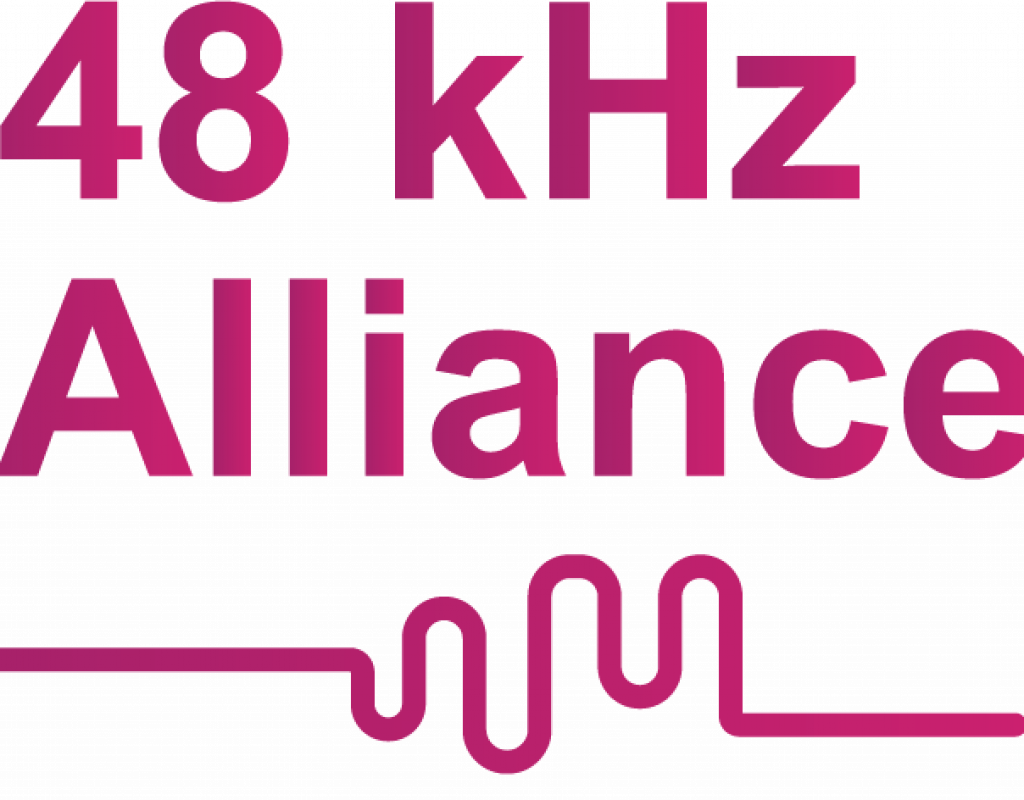
Thanks to a recent —and extremely rare— inaccurate public statement by Rob Walch, I was catapulted into creating the new 48 kHz Alliance. For decades, I have been a 48 kHz evangelist. In 2016, I published the article All audio production & distribution should go 48 kHz, to which I often link in my workflow articles and reviews. Now, I am ironically thankful to Rob Walch for indirectly inspiring me to create the 48 kHz Alliance , its associated knowledgebase/wiki and awards. I generally concur with 99.9% of Rob Walch’s statements and I immensely appreciate and applaud his countless contributions to the production and distribution community. However, in this case, Rob Walch pressed a very sensitive pressure point. It hurt, but I’m grateful. Despite his allegation, I have personally tested 18 players and podcatchers on Android, iOS and on the web, and they all play 48 kHz files in a podcast RSS feed perfectly. They include the majority —which play the original native file— and those few which (sadly) make a copy of nearly all files (details ahead). The new RØDECaster Pro mixer/recorder is fortunately 48 kHz-exclusive and has earned an award from the 48 kHz Alliance. My friend Chris Curran’s Podcast Engineering Show (as 4 of my active shows do) is produced and distributed at 48 kHz, and plays perfectly in all 18 podcatchers and players I tested, including Libsyn’s own embeddable player! Chris Curran’s Podcast Engineering Show has earned an award in the 48 kHz Alliance. Ahead you’ll learn more about the Alliance, its philosophy and growing knowledgebase/wiki, as well as the 18 players and podcatchers I tested.
In this article
In this article you’ll find:
- A summary of the 48 kHz Alliance’s philosophy
- BeyondPodcasting episode 12
- Rob Walch’s statement
- 18 podcast players and podcatchers I tested personally
- Players I verified via published specs
- Podcast media hosts & tools
- Interactive telephone systems and why I use 48 kHz for those too
- Live streaming and audiobooks
- More about the 48 kHz Alliance
A summary of the 48 kHz Alliance’s philosophy
48 kHz audio sampling is our preferred standard for all of the reasons expressed in my original article All audio production & distribution should go 48 kHz. It’s not about the slight superior audible quality of 48 kHz. It’s about:
- Being compatible with the video world. Even audio-only productions should —at least occasionally— be part of a video documentary or a video promo, and therefore facilitate it, not complicate it.
- Making our production standard match our distribution standard for 99% of the listeners, so only the 1% needs to suffer a downsampling, and 0% ever has to suffer an upsampling (which is even less desirable).
BeyondPodcasting episode 12
Above, BeyondPodcasting episode 12 (40 minutes, 16 seconds), with in-studio guests Emmy-award winning actor and voiceover talent Memo Sauceda and sound engineer Rafael Pereira.
Rob Walch’s statement
Above is Rob Walch’s inaccurate and disparaging statement about 48 kHz (18 seconds) from The Feed episode 135.
Podcast players and podcatchers I tested personally
I personally tested all of the 18 below on the indicated platforms, with 48 kHz source files in the RSS feed, with perfect playback. The source files I used were a combination of mine (with all except the Libsyn player, since I don’t currently host at Libsyn) and Chris Curran’s Podcast Engineering School’s episode 115, whose media files and RSS feed are hosted by Libsyn. Here’s the list in alphabetical order, together with short comments.
1—Apple Podcasts player (iOS, free)
2—BeyondPod podcatcher/player (Android, free)
3—Blubrry embedded player (web)
4—CastBox – Podcast Radio Music (Android, free)
5—Google Podcasts podcatcher/player (Android, free)
6—Libsyn embedded player (web)
Just like all of the others, the Libsyn web player plays 48 kHz files perfectly!, as tested with Chris Curran’s Podcast Engineering School episode 115.
The above screenshot demonstrates that the MP3 file of this episode (which I downloaded directly from the Libsyn embedded player at PodcastEngineeringSchool.com) is indeed 48 kHz.
7—LucidPod (Android, free)
8—Overcast (iOS, free)
9—Podcast & Radio Addict (Android, free)
10—Pocket Casts (Android, iOS, web, premium paid app)
My current favorite premium app on Android.
11—Podcast App by Player FM (Android, free version)
12—Podcast Republic (Android, free)
13—RadioPublic’s player (Android, iOS, web, free)
14—Spotify (Android, iOS, web)
At present, Spotify unfortunately makes a copy of our original file (except for exceptions with certain producers). However Spotify makes that copy, it still plays perfectly even when the original file is 48 kHz.
15—Spreaker Podcast Radio (Android, iOS, free)
16—Spreaker embedded player (web)
This was tested with my CapicúaFM show’s 48 kHz episodes, which Spreaker includes as a pass-through (thank you Rob Greenlee!), since it is not hosted with Spreaker.
17—Stitcher SmartRadio (Android, iOS, web)
18—TuneIn (Android, iOS, web)
To reiterate, all 18 played 48 kHz perfectly, using a combination of MP3 and AAC (M4A) files. (The only combination not tested so far with AAC/M4A is the Libsyn web player. UPDATE: Chris published his episode 118 of Podcast Engineering School in AAC/M4A 48 kHz and it too plays perfectly in the Libsyn web player.)
Standby for my upcoming article which compares how each podcatcher/player/platform handles show notes. They vary considerably.
Players I verified via published specs
I verified via published specs these, even though I don’t have a device to test personally:
- Blackberry 10, see official listing here.
- Blackberry KEYone, see comment by KNReddy here.
- Microsoft Windows Phone 8, see official listing here.
They all indicate official 48 kHz audio support.
Podcast media hosts & tools
Ironically, despite Rob Walch’s statement, Libsyn’s own web player completely supports 48 kHz, as proven by Chris Curran’s Podcast Engineering Show earlier in this article. (Rob Walch is the VP of Libsyn.)
Blubrry’s free PowerPress plugin is agnostic to the media file’s sampling frequency and therefore its included web player supports 48 kHz perfectly. The free PowerPress plugin works with self-hosted shows, those which host with Blubrry and even with those who host with competitors of Blubrry.
Spreaker’s web player plays 48 kHz passively, and only downsamples when streaming, without any chip-munking in either case.
The Spreaker Studio app for recording and live streaming only outputs 44.1 kHz, but properly downsamples any source that it may receive at 48 kHz, be it a live microphone connected digitally or a 48 kHz media file in its virtual carts.
Interactive telephone systems
Standard POTS (Plain Old Telephone Service) is —by nature— limited to 180 Hz to 3.2 kHz and when digitized, is done with a 8 kHz sampling rate. That is the reason why I always record and contract voiceovers for interactive telephone systems at 48 kHz, both for me and my clients! Why? Because downsampling from 48 kHz is simpler math, since 48 is a direct multiple of 8, so the downsample is much simpler than trying to do it from 44.1 kHz, which would add more artifacts. Years ago, with the phone systems I used to configure my interactive telephone systems, I used to downsample them myself to 8 kHz, since at that time, those systems would exclusively accept 8 kHz WAV files. Nowadays, the systems I use fortunately accept them as 48 kHz WAV files and they do the downsample to 8 kHz on the fly when played. So now, I upload the 48 kHz files as-is. That means that when these systems eventually upgrade to HD Voice, I won’t have to upload the audio files again, since they are already HD Voice ready and future-proof 🙂
Live streaming and audiobooks
I recognize that some audio live streaming platforms unfortunately use an audio sampling frequency lower than 48 kHz. In past articles, I have demonstrated how to downsample on the fly for those exceptions, without suffering any chip-monking mentioned by Rob Walch, and retaining the 48 kHz advantages for all other distribution and syndication. (Spreaker’s streaming fortunately does the downsampling automatically in my testing.)
The same applies to ACX audio production for Audible audiobooks, until ACX sees the writing on the wall and begins officially supporting 48 kHz, even if not exclusively. (It’s certainly possible that ACX already supports 48 kHz unofficially, but I haven’t tested that yet. Due to time pressures from the authors who have hired me to produce audiobooks, I have —so far— uploaded files to ACX at its officially supported sampling rate, to avoid a possible rejection and subsequently, a need to resubmit. I’ll probably test it when I convert one of my own books into an audiobook.) As stated in point 2 of 48 Khz Alliance’s philosophy, we want to make our production standard match our distribution standard for 99% of the listeners, so only the 1% needs to suffer a downsampling, and 0% ever has to suffer an upsampling (which is even less desirable than a downsample).
More about the 48 kHz Alliance
For more about the 48 kHz Alliance, visit 48kHzAlliance.com, part of the BeyondPodcasting website. Its knowledgebase is constantly growing.
(Re-)Subscribe for upcoming articles, reviews, radio shows, books and seminars/webinars
Stand by for upcoming articles, reviews, and books. Sign up to my free mailing list by clicking here. If you previously subscribed to my bulletins and no longer receive them, you must re-subscribe due to new compliance to GDPR. Most of my current books are at books.AllanTepper.com, and my personal website is AllanTepper.com. Also visit radio.AllanTepper.com.
Si deseas suscribirte (o volver a suscribirte) a mi lista en castellano, visita aquí. Si prefieres, puedes suscribirte a ambas listas (castellano e inglés).
Suscribe to his BeyondPodcasting show at BeyondPodasting.com.
Subscribe to his Tu radio global show at Turadioglobal.com.
Subscribe to his Tu salud secreta show at TuSaludSecreta.com.
Subscribe to his award-winning CapicúaFM show at CapicúaFM.com.
Save US$20 on Google Fi, my favorite mobile telephony and data service
Click here to save US$20 on Google Fi, which now works on iPhone and Android. With Google Fi (covered previously in several articles), there is no extra charge for data-only SIM cards on the same account, for up to 10 devices. You only pay for the total data, and data is free after 6 GB per month. So you could be using one Google FI SIM card on your primary phone, another in a tablet or secondary phone (or third, of fourth…).
FTC disclosure
No manufacturer is specifically paying Allan Tépper or TecnoTur LLC to write this article or the mentioned books. Some of the other manufacturers listed above have contracted Tépper and/or TecnoTur LLC to carry out consulting and/or translations/localizations/transcreations. Many of the manufacturers listed above have sent Allan Tépper review units. So far, none of the manufacturers listed above is/are sponsors of the TecnoTur , BeyondPodcasting or TuRadioGlobal programs, although they are welcome to do so, and some are, may be (or may have been) sponsors of ProVideo Coalition magazine. Some links to third parties listed in this article and/or on this web page may indirectly benefit TecnoTur LLC via affiliate programs. Allan Tépper’s opinions are his own.
Copyright and use of this article
The articles contained in the TecnoTur channel in ProVideo Coalition magazine are copyright Allan Tépper/TecnoTur LLC, except where otherwise attributed. Unauthorized use is prohibited without prior approval, except for short quotes which link back to this page, which are encouraged!

